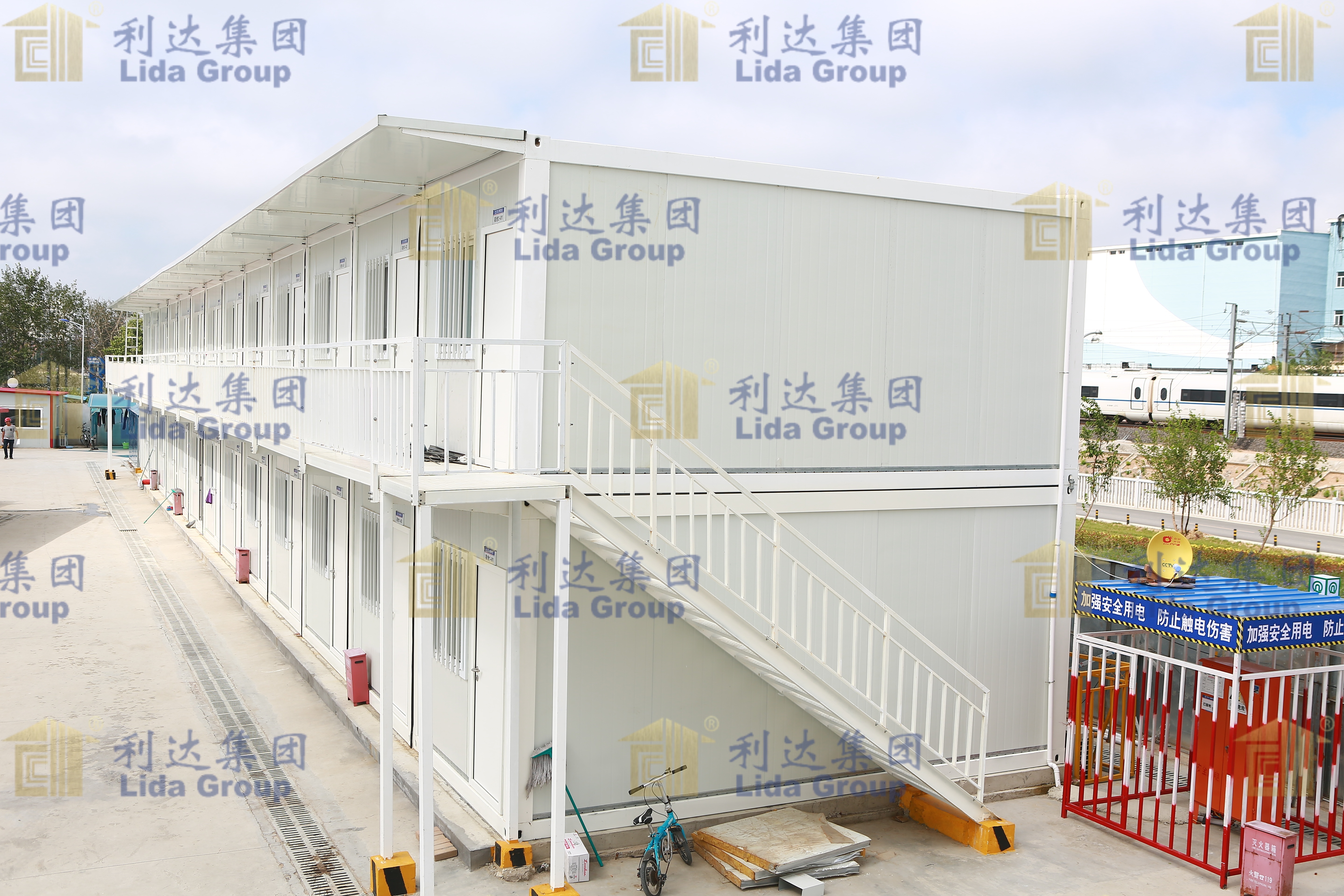Tel: 0086-532-88966982
0086-532-88965892
Website: www.lidajituan.com
E-mail: sales@lidajituan.com
Head office: 5th Floor, Building A, Dalen Center, 180 Haier Road, Qingdao, 266000, China
Arctic Mining Camp Container House Systems Extreme Cold Resistance Lida Group
Classification:Industry News
Release time:2025-08-05 09:00
Arctic Mining Camp Container House Systems Extreme Cold Resistance Lida Group
The relentless minus 56°C darkness of Canada's Diavik diamond mine reveals construction's ultimate proving ground. Here, where conventional steel fractures like glass and hydraulic systems freeze solid, Lida Group's engineered container house complex stands operational – maintaining habitable conditions while neighboring structures succumb to frost heave and brittle failure. This resilience isn't accidental; it's the product of specialized container building technologies forged through three decades of polar innovation that transform remote mining operations from logistical nightmares into sustainable enterprises.
Arctic operations present unique challenges that render traditional constructions obsolete. Standard steel loses ductility below -45°C, fracturing under stress like shattered pottery. Thermal bridging siphons heat through structural members, creating ice-lined interiors despite roaring heaters. Permafrost degradation beneath foundations causes catastrophic shifting, while hurricane-force winds drive ice crystals that sandblast surfaces into perforated ruins. Lida Group's polar-grade camp container systems conquer these threats through material science breakthroughs and precision engineering.
The foundation lies in metallurgical innovation. Nickel-alloyed S355J2W steel maintains impact resistance down to -60°C – verified through Charpy V-notch testing showing 100J absorption at extreme temperatures. Cryogenic welding protocols control hydrogen diffusion preventing cold cracking in joints, while slotted connection systems accommodate thermal contraction without stress fractures. Composite wall systems integrate aerogel-enhanced panels achieving R-50 values within 200mm profiles, creating thermal breaks that reduce heat loss by 63% compared to conventional builds. Triple-glazed windows with suspended low-e films and krypton gas fills achieve U-values of 0.62 W/m²K, while magnetic gasket systems create hermetic seals against wind-driven snow infiltration.

Permafrost preservation becomes critical infrastructure. Thermosyphon foundations embed passive heat pipes that redirect warmth upward, preventing ground thaw beneath structures. Elevated floors with 300mm EPS insulation create thermal buffers, while ventilated subfloor cavities maintain frozen strata through convection currents. These systems demonstrate less than 5mm differential settlement over five years in continuous permafrost zones – versus 150mm+ in conventional builds causing structural failure. For mobile exploration camps, screw pile foundations install through ice and snow without concrete curing, supporting helicopter-transportable modular house units deployed in under eight hours.
Operational innovations address human factors in extreme environments. Oxygen enrichment systems maintain 21% concentration at 4,000m elevations preventing altitude sickness. Circadian lighting combats seasonal affective disorder in winter darkness, while UV-C sterilization in HVAC systems reduces airborne pathogens in confined spaces. Acoustic engineering delivers 52dB noise reduction from howling winds and equipment, enabling restorative sleep critical for safety. These features reduced medical evacuations by 47% at Greenland rare earth operations compared to previous camps.
Mining-specific applications demonstrate engineered precision. Core logging laboratories feature vibration-damped floors maintaining micron-level measurement accuracy despite nearby drilling. Explosives magazines incorporate thermal banking systems keeping temperatures between -15°C and +25°C year-round. Process control rooms achieve ISO Class 8 air cleanliness excluding abrasive dust from instrumentation. At a nickel mine in Norilsk, these specialized office container units maintained operations during -54°C polar vortex events that halted conventional facilities.
Cross-industry adaptation extends to oil and gas frontiers. Arctic drilling camps utilize identical thermal break technologies in control modules, while pipeline monitoring stations incorporate self-regulating trace heating preventing instrument freeze. LNG plant accommodations feature methane detection systems triggering airlocks during leaks. The same structural principles enable offshore installations to withstand ice floe impacts in the Barents Sea through reinforced corner posts and sacrificial collision panels.
Validation comes from extreme deployments:
- Prudhoe Bay Oil Field: Maintained +21°C interiors during -54°C with 90km/h winds
- Siberian Palladium Mine: Survived 150km/h ice storms without envelope compromise
- Greenland Zinc Operation: Prevented permafrost degradation under 200-bed camp
- Alaskan Pipeline Camp: Operated continuously during 10-day -50°C cold snap
Lida Group's manufacturing rigor ensures field reliability. Robotic welding in climate-controlled facilities achieves 0.1mm tolerances impossible in Arctic conditions. Cryogenic testing subjects materials to -65°C before approval, while accelerated weathering chambers simulate decade-long exposure in months. GPS-guided installation compensates for magnetic interference near poles, and just-in-sequence delivery eliminates onsite storage damage. These protocols yield defect rates 92% lower than site-built alternatives.
Future technologies push boundaries further:
- Phase-change windows dynamically modulating solar heat gain
- Hydrogen fuel cell integration for emission-free power
- Self-healing coatings repairing micro-abrasions from ice crystals
- Autonomous drones conducting thermal envelope inspections
- AI-driven predictive maintenance forecasting component failures
When Diavik mine geologists sleep soundly through blizzards and pipeline technicians work comfortably at -50°C, Lida Group's container house systems prove human habitation needn't sacrifice safety for operational necessity in Earth's final frontier. These engineered habitats transform from temporary shelters into strategic assets that attract skilled talent, ensure operational continuity, and demonstrate that through material science mastery, even the most hostile environments become spaces where human ingenuity thrives.

modular house,office container,container house,camp container ,constructions
Contact Us
Head Office: 5th Floor,Building A,Darron Center,No.180,Haier Road,Qingdao, 266000,China
Tel: 0086-532-88966982 88965892 Fax:0086-532-88965571
WhatsApp:+86 13793209022
Mobile/Wechat:+86-15166671720
Email: sales@lidajituan.com Website: www.lidajituan.com
Alternate Website: www.lidamodularhouse.com
Head Office: 5th Floor,Building A,Darron Center,No.180,Haier
Road,Qingdao, 266000,China
Tel: 0086-532-88966982 88965892
Fax:0086-532-88965571
Email: sales@lidajituan.com
Website: www.lidajituan.com
Alternate Websit: www.prefabhousecn.com
Wechat/WhatsApp:+86-13793209022
Copyright(c)2023 All Rights Reserved SEO Business license

